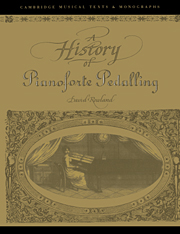Book contents
- Frontmatter
- Contents
- Acknowledgements
- List of abbreviations
- Introduction
- PART I The instruments
- PART II Pedalling and the early pianists
- 3 Documentary accounts of early pedalling
- 4 Early techniques of the pedals as described in tutors
- 5 Early pedal markings
- 6 Mozart and his contemporaries
- PART III Pedalling after c.1800
- APPENDIX: Chapters on pedalling from piano tutors
- Notes
- Select bibliography
- Index
5 - Early pedal markings
Published online by Cambridge University Press: 16 November 2009
- Frontmatter
- Contents
- Acknowledgements
- List of abbreviations
- Introduction
- PART I The instruments
- PART II Pedalling and the early pianists
- 3 Documentary accounts of early pedalling
- 4 Early techniques of the pedals as described in tutors
- 5 Early pedal markings
- 6 Mozart and his contemporaries
- PART III Pedalling after c.1800
- APPENDIX: Chapters on pedalling from piano tutors
- Notes
- Select bibliography
- Index
Summary
Pedal markings occur consistently in piano music from the early 1790s. They were first used in France and within a few years were introduced in England. It took a little longer for them to reach the rest of Europe, notably Vienna, but they were common even there in the early years of the nineteenth century.
A study of these pedal markings is vital to our understanding of early techniques. They contain a wealth of evidence that complements the documentary sources. Even so, they are flawed in one important respect: they do not necessarily represent the composer's full intentions. Czerny, for example, noted in his discussion of pedalling that
beethoven, in particular, employed it in the performance of his pianoforte works much more frequently than we find it indicated in those compositions.
Beethoven was not unique. Even a cursory examination of the literature shows inconsistencies of approach between works by the same composer, or between composers of the same school. One of the reasons for this must have been commercial pressures: it might be inappropriate to include pedalling in a piece advertised ‘for harpsichord or pianoforte’, for example, and it would certainly increase the cost of engraving if it were done in detail. Another reason was doubtless the thoroughness or otherwise of individual composers. Dussek, for example, was renowned for his command of the pedals, yet seems to have been remarkably lazy in providing indications for them.
- Type
- Chapter
- Information
- A History of Pianoforte Pedalling , pp. 52 - 81Publisher: Cambridge University PressPrint publication year: 1993



